Loading AI tools
Between 1864 and 1958, Queensland Railways ordered 47 types of locomotives for purposes such as freight, passenger and mail train use.
Until 1889, each of the isolated sections of the Queensland Railways adopted its own locomotive numbering system. With the impending joining of most of the sections, in 1890 a new centralised classification system was adopted to eliminate duplications. Locomotives on the Southern & Western Railway retained their existing numbers, with locomotives on other networks renumbered where there was a duplication.[1][2]
The classification system consisted of a letter, indicating the number of driving axles, followed by a number, indicating the cylinder diameter in inches and factions of inches. This was confusing for two reasons:
- it differed from the international system
- it could lead to several classes having the same classification number
Where classification numbers were duplicated, the classes were usually distinguished by the name of the builder, e.g. A10 Baldwin, A10 Fairlie, A10 Neilson.[1][2]
In the case of tank locomotives, the number of driving wheels was added as a prefix, e.g. the 6D16 class had six driving wheels. With all four wheel tank locomotives, the prefix was dropped, thus the 6D16 class became the D17 class.[1][2]
| Number of driving axles | International classification | QR classification |
|---|---|---|
| 1 | A | - |
| 2 | B | A |
| 3 | C | B |
| 4 | D | C |
| 3 (Tank locomotive) | D |
Improved versions of a similar class were given a second identical letter. For example, the improved version of the D17 was the DD17.
| Classification | |||||||
|---|---|---|---|---|---|---|---|
| Image | Years built | Whyte notation | Designation | Cylinder diameter (inches) | Driving axles | Type | Number in Class |
 | 1864 | 2-4-0 | A10 Avonside | 10 | 2 | Freight[citation needed] | 4 |
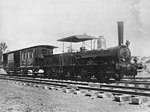 | 1865-1866 | 0-4-2 | A10 Neilson class – Originally B class | 10 | 2 | Mixed | 13 |
| 1867 | 2-6-0 | B11 class – Originally C class | 11 | 3 | Freight[3] | 4 | |
 | 1867 | 0-6-6-0 | Double boilered Cross class | 17 | 6 | Freight[citation needed] | |
 | 1874-1882 | 2-6-0 | B12 class – Originally E class | 12 | 3 | Mixed use[4] | |
 | 1874 | 0-4-4-0 | 8D11 class | 11 | 4 | Tank[citation needed] | |
 | 1877 | 2-4-0 | A10 Fairlie – Originally A class | 10 | 2 | Freight[5] | |
 | 1877 | 2-4-0 | A10 Ipswich | 10 | 2 | Freight[citation needed] | |
| 1878 | 2-4-0 | A11 class – Originally Large A class | 11 | 2 | Mixed[6] | ||
 | 1878 | 4-4-0 | A12 (small) class – American Passenger class | 12 | 2 | Passenger | 3 |
 | 1879 | 4-4-0 | A10 Baldwin – Originally American Passenger class | 10 | 2 | Passenger[7] | |
 | 1879 | 2-8-0 | C13 Baldwin class | 13 | 4 | Freight[8] | |
 | 1879 | 2-8-0 | C15 class – Originally Small Consolation class | 15 | 4 | Mixed[9] | |
 | 1880 | 2-6-0 | B11 Baldwin class | 11 | 3 | Freight, then shunting[10] | |
 | 1881 | 2-4-2T | 4D9 class | 9 | 2 | Tank (Mixed use)[citation needed] | |
 | 1882-1891 | 4-4-0 | A12 class – Originally American Passenger class | 12 | 2 | Passenger[11] | |
| 1882 | 0-6-0T | 6D11½ Motor class | 11 1/2 | 3 | Tank (Freight)[12] | ||
 | 1882 | 0-6-2T | 6D13 – formerly F-class | 13 | 3 | Tank (Freight)[13] | |
 | 1882 | 2-8-0 | C16 Baldwin class – Large Consolidation class | 15 | 4 | Freight[14] | |
| 1883-1895 | 4-6-0 | B13 class | 13 | 3 | Mixed use[15] | ||
 | 1883 | 2-8-0 | C13 Dubs class | 13 | 4 | Freight[16] | |
 | 1884-1885 | 2-4-2T | 4D10 class | 10 | 2 | Tank (Passenger)[17] | |
 | 1884 | 2-8-2T | 8D15 class | 15 | 4 | Tank (Heavy Freight)[18] | |
| 1889-1899 | 4-6-0 | B15 class | 15 | 3 | Freight[19] | ||
 | 1894-1895 | 4-4-0 | A14 class | 14 | 2 | Passenger[20] | |
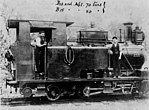 | 1898 | 0-4-2T | 4D11½ Abt class | 11 | 2 | Tank (Rack Freight)[21] | |
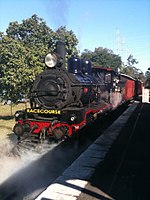 | 1899-1926 | 4-6-0 | PB15 class | 15 | 3 | Passenger, Shunter[22] | |
 | 1900-1923 | 0-6-0T | 6D8½ class | 8 1/2 | 3 | Tank (Passenger)[citation needed] | |
 | 1900-1915 | 0-6-0T | 6D13½ Abt class | 13 1/2 | 3 | Tank (Rack Freight)[23] | |
 | 1901-1902 | 4-6-2T (originally), 4-6-4T (after rebuild) | 6D16 class | 16 | 3 | Tank (suburban passenger)[24] | |
| 1902 | 0-6-0ST | 6D11½ Crane class | 11 1/2 | 3 | Saddle Tank (Inspection)[25] | ||
 | 1903-1918 | 4-8-0 | C16 class | 16 | 4 | Poison trains, mail trains, goods trains[26] | |
 | 1904-1905 | 0-6-0T | 6D13½ later B13½ class | 13 1/2 | 3 | Tank (Shunter)[27] | |
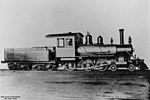 | 1908 | 4-6-0 | B13 Baldwin class | 13 | 3 | Freight[citation needed] | |
 | 1911 | 4-6-0 | B17 class | 17 | 3 | Express Passenger[28] | |
 | 1914 | 4-8-0 | C18 later CC19 class | 18 (then 19) | 4 | Express passenger[29] | |
 | 1918 | 2-6-2 | B16½ class | 16 1/2 | 3 | Passenger[19] | |
 | 1920-1953 | 4-8-0 | C17 class | 17 | 4 | Mail trains, suburban passenger, freight trains and passenger[30] | |
| 1922-1935 | 4-8-0 | C19 class | 19 | 4 | Express passenger[31] | ||
 | 1923-1927 | 0-6-2 | B9½ class | 9 | 3 | Freight[citation needed] | |
 | 1924-1942 | 4-6-4T | 6D17 later D17 class | 17 | 3 | Tank (suburban passenger)[24] | 30 |
 | 1926-1947 | 4-6-2 | B18¼ class | 18 1/4 | 3 | Express passenger, suburban passenger, mail trains and heavy freight[28] | 83 |
 | 1943 | 2-8-2 | AC16 class | 16 | 4 | Mixed use[32] | 20 |
 | 1943-1945 | 4-8-2+2-8-4 2′D1′+1′D2′ | Australian Standard Garratt | 14.5 | 8 | Heavy freight[33] | 57 |
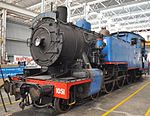 | 1948-1952 | 4-6-4T | DD17 class | 17 | 3 | Suburban passenger[31] | 12 |
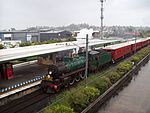 | 1950-1958 | 4-6-2 | BB18¼ class | 18 1/4 | 3 | Express passenger, mail trains, suburban passenger and heavy freight trains[34] | 55 |
 | 1950-1951 | 4-8-2+2-8-4 | Beyer-Garratt class | 13 3/4 | 8 | Freight[35] | 30 |
Wikiwand in your browser!
Seamless Wikipedia browsing. On steroids.
Every time you click a link to Wikipedia, Wiktionary or Wikiquote in your browser's search results, it will show the modern Wikiwand interface.
Wikiwand extension is a five stars, simple, with minimum permission required to keep your browsing private, safe and transparent.